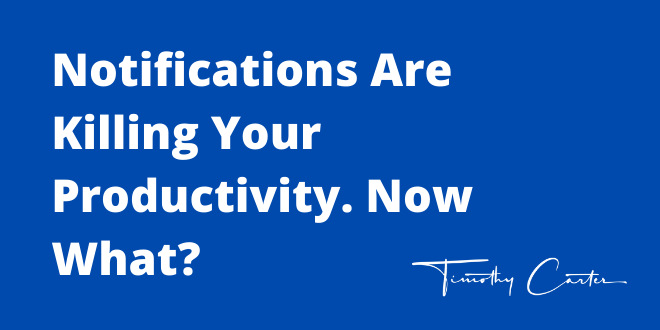
How to Conquer the Biggest Problems in Startup Scaling
June 26, 2022
How to Handle Competition With Your New Website
June 28, 2022Technology has revolutionized the way we live, work, and play. It’s a field of miraculous, magical developments that always have the power to help us save time, do more, and ultimately become more productive.
Right?
Technology Isn’t Always Productive
You might have had some experiences with technology that make you question whether a new app, a new gadget, or a new system is actually adding value to your life.
For example, you might have upgraded to a new project management system that ends up taking twice as much time to use. Or, even more commonly, you might have found yourself endlessly scrolling through your Twitter feed in the middle of an important project.
As a generalized, overarching trend, technology definitely makes us productive.
We’re capable of far more than we were even 10 years ago, and new industries and opportunities emerge every year from new tech. But technology isn’t always productive – in fact, it can sometimes rob you of productive time.
What steps can you take to ensure that all your technology choices end in higher productivity (or at least neutrality)?
Here’s How to Use Technology Appropriately
Outline Your Goals in Advance
Before adopting any new technology, it’s important to outline all your goals in advance. What, exactly, are you hoping to achieve?
Many new technologies make vague promises about making your life better, and many consumers end up buying those products because they seem, in some ambiguous way, “better” than what you currently have.
For example, you have the option to upgrade your refrigerator to a smart fridge. But what are you actually hoping to achieve from this upgrade? Do you want your food to spoil less often? Do you want to stay better organized with your food purchases? A refrigerator upgrade may not be necessary to achieve these goals.
What does productivity mean to you?
You’ll also need to think about what “productive” actually means to you. If a piece of new technology improved your productivity, what would that look like? Some technologies automate or simplify some aspect of your job (or life), only to introduce new problems.
For example, you might develop an algorithm that automatically generates a reading list for you – but it doesn’t always work quite right, so you have to sort through the list manually. You’ve saved an hour on task A, but you’re spending an hour on a new task, task B.
The clearer your goals are, the less likely you’ll be to use technology that has a net negative effect.
Rely on Objective Data
When choosing new technologies and evaluating their ability to improve your productivity, you need to rely on hard, objective data. What, specifically, is this improving and how much is it improving it?
This will help you filter out:
- Cognitive biases. Human beings aren’t very logical creatures. We’re afflicted with a variety of cognitive biases that can distort how we perceive things.
- Subjective feelings. You might feel like your phone is making you more productive, but the data may say something otherwise. This frequently happens with new acquisitions; we often like to justify our investments and pretend there are benefits when there aren’t any.
- Claims and anecdotal reports. Tech companies often promote their products by citing good reviews and happy customers. But anecdotal evidence and personal claims rarely tell the full story.
Always Review Your Options in Depth
When searching for new technology, you’ll probably have many options to choose from. There are dozens, if not hundreds, of competitors in almost every imaginable niche, so it’s important to review your choices carefully before making a final call.
Consider these choices for your technology:
- Features and functionality. What does this product have that other competing products don’t have? Even more importantly, what does it do to boost your productivity?
- Flexibility and scalability. How much can this product change, grow, and evolve with your company? This is especially important if you’re going to scale your business.
- Intuitiveness and learnability. How long will it take to learn how to use this system properly? Low intuitiveness can compromise even the best tech investment.
- Ratings and reviews. When combined with other considerations, ratings and reviews can be valuable in helping you make up your mind.
- Objective metrics. More importantly, though, you’ll need to look at the numbers. How many hours could this save you? What new tasks will it require?
- Costs. There may be a new app or gadget that can boost your productivity by 10 percent. But if it costs $10,000 a year, it may not be worth it. Consider the costs as well.
Automate Whatever You Can – but Understand the Limits
Automation is one of the best ways to save time and increase productivity in a business environment. Accordingly, you should strive to automate whatever you can.
That said, there are some limitations to what you can automate effectively. Automation relies on predictability and consistency; in an environment with unknown variables or areas that require human creativity, automation becomes less practical.
Excessive automation can also compromise certain aspects of your business; for example, you might be able to automate all your email marketing and sales campaigns, but it could turn people off for being too repetitive and “cold.”
Minimize Apps
For the most part, you should strive to limit the number of apps you rely on, both to simplify your infrastructure and to minimize time spent jumping between systems.
You can do this by consolidating the functionality of several apps into one, relying on integrations to send data to and from various apps, and by resisting the temptation to buy new apps just because they’re new and look cool.
Set Limits and Restrictions
Some apps and devices make it hard to be productive because they occupy too much of your time or interfere with your life in some crucial way. Accordingly, it’s advisable to set limits and restrictions for yourself, sometimes within the apps themselves.
For example:
- Screen time. Most smartphones and modern devices have built-in settings and apps to help you track your screen time. You might even be able to limit it. This is especially important for apps and devices that tend to distract you or pull you away from more productive work.
- Notifications and distractions. You should also be aware that even one small distraction has the potential to harm your productivity for nearly an hour; it takes time to build focus and momentum, and even a seemingly small distraction can ruin that. Turn off notifications wherever and whenever possible and consider closing out apps that might distract you (such as your email account during a busy workday).
- Communication. Communication is valuable in any workplace or home, but modern technology makes it all too easy to get in touch with someone – even when they’re busy. Don’t drop everything you’re doing every time you get an email, instant message, or request for a video call; use your communication apps intentionally and mindfully.
Measure and Reflect
Rely on a combination of built-in tech tools, time trackers, and other analytics dashboards to keep track of your productivity and your progress. How are you using the various tools available in your arsenal? How much time are you spending on various platforms and on screens? How many hours are you working and how much were you able to get done?
Consistently measure your productivity and observe how it changes over time.
Don’t just assume that a new piece of tech is boosting your performance; try to prove it. If it’s not working for you, consider cutting it and moving onto something else.
If you aren’t careful, a new app, a new gadget, or another high-tech investment can end up working against you, either by distracting you, interfering with your work, or making something you were already doing harder.
As long as you think critically about your new tech adoption and continue to be discerning in your tech infrastructure, you can end up benefitting from new tech.
Originally appeared in ReadWrite






